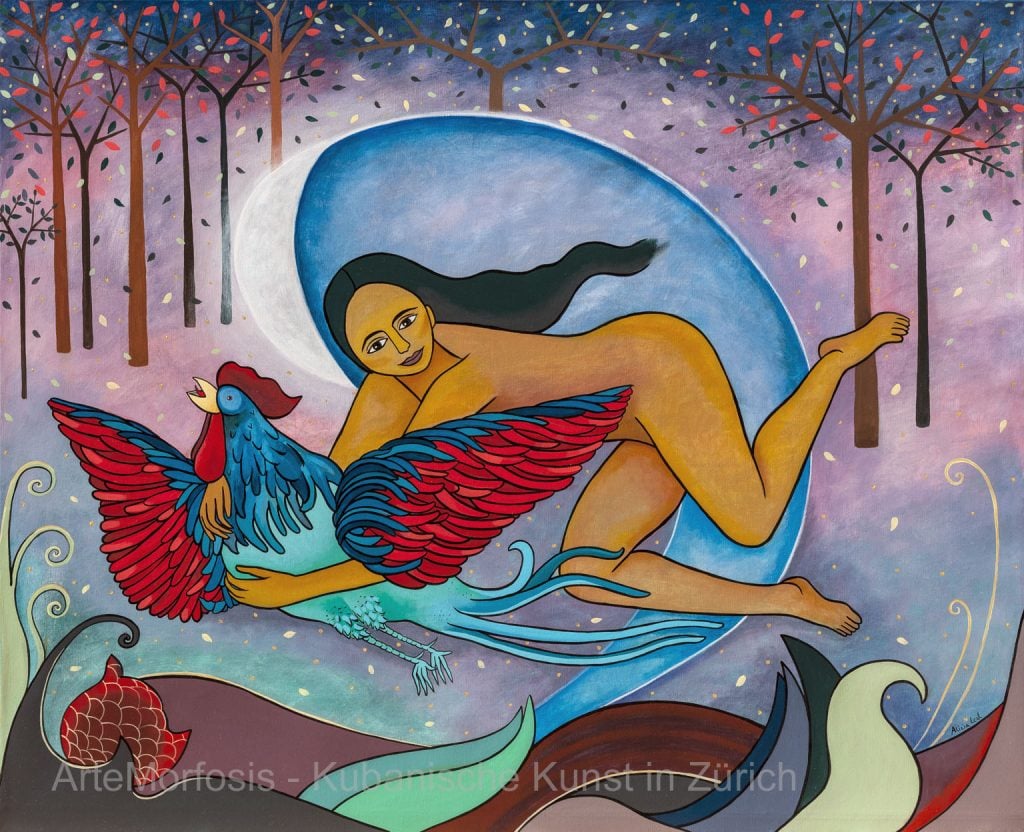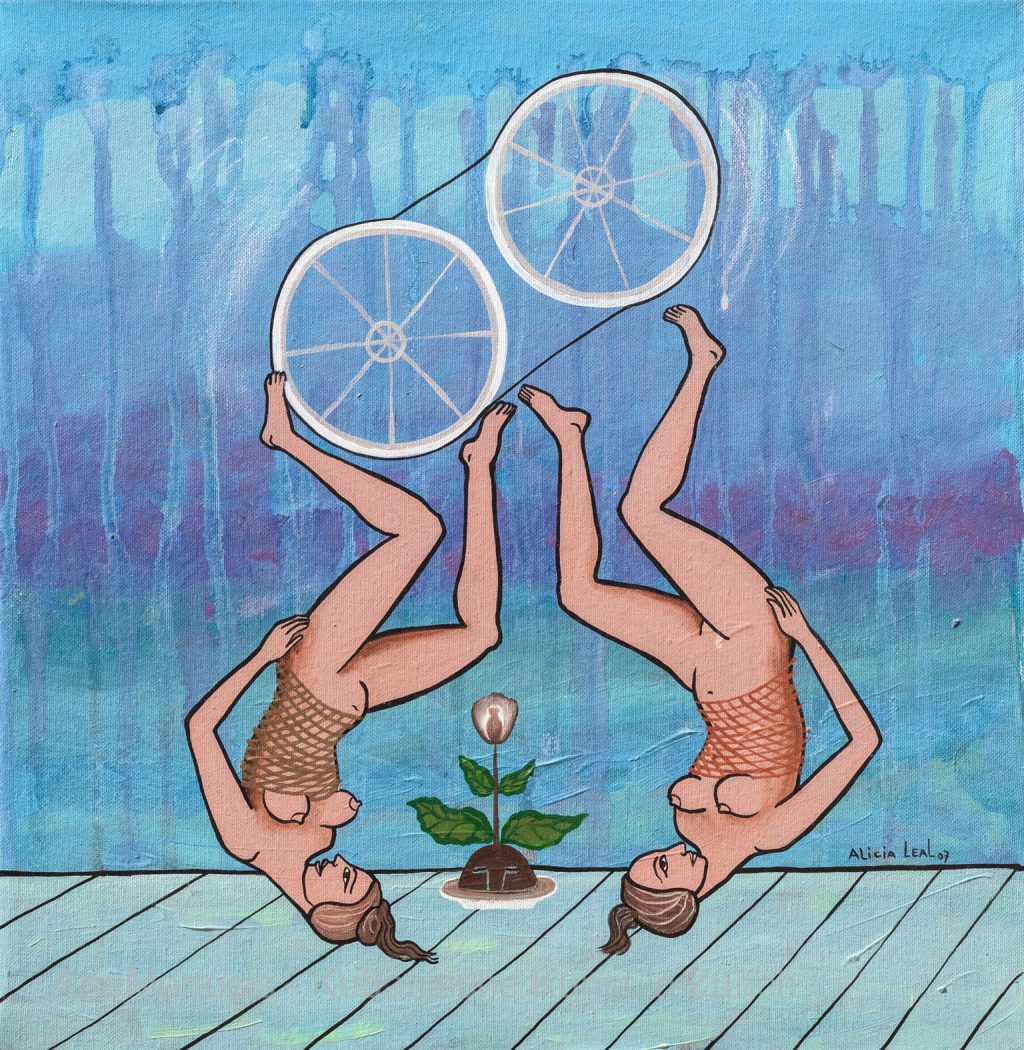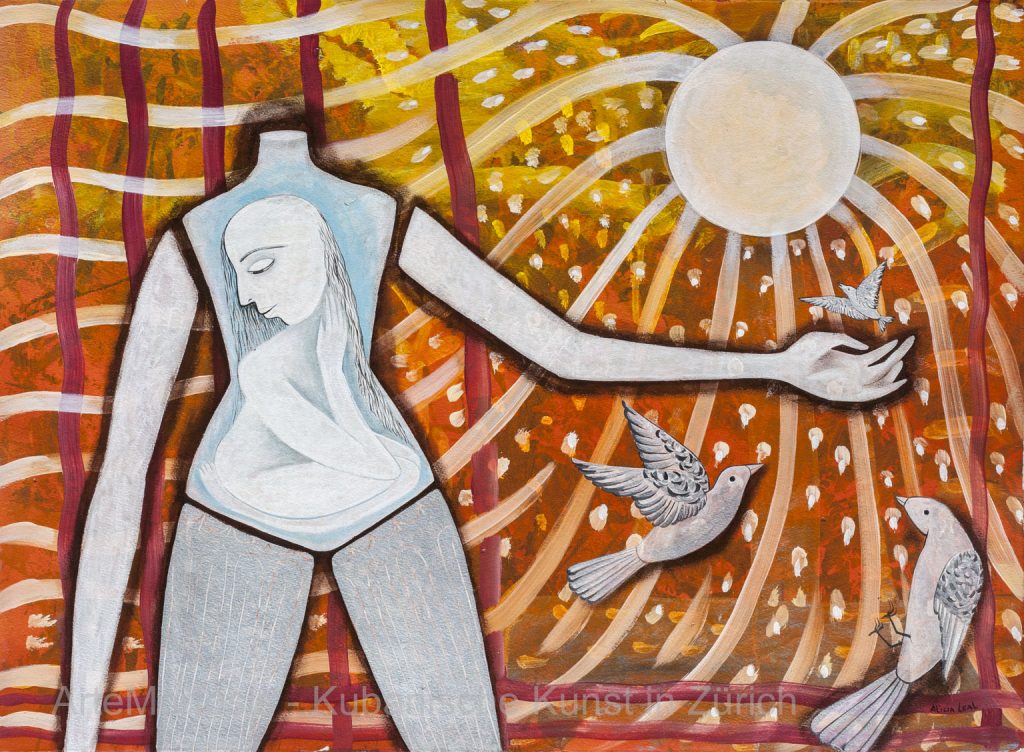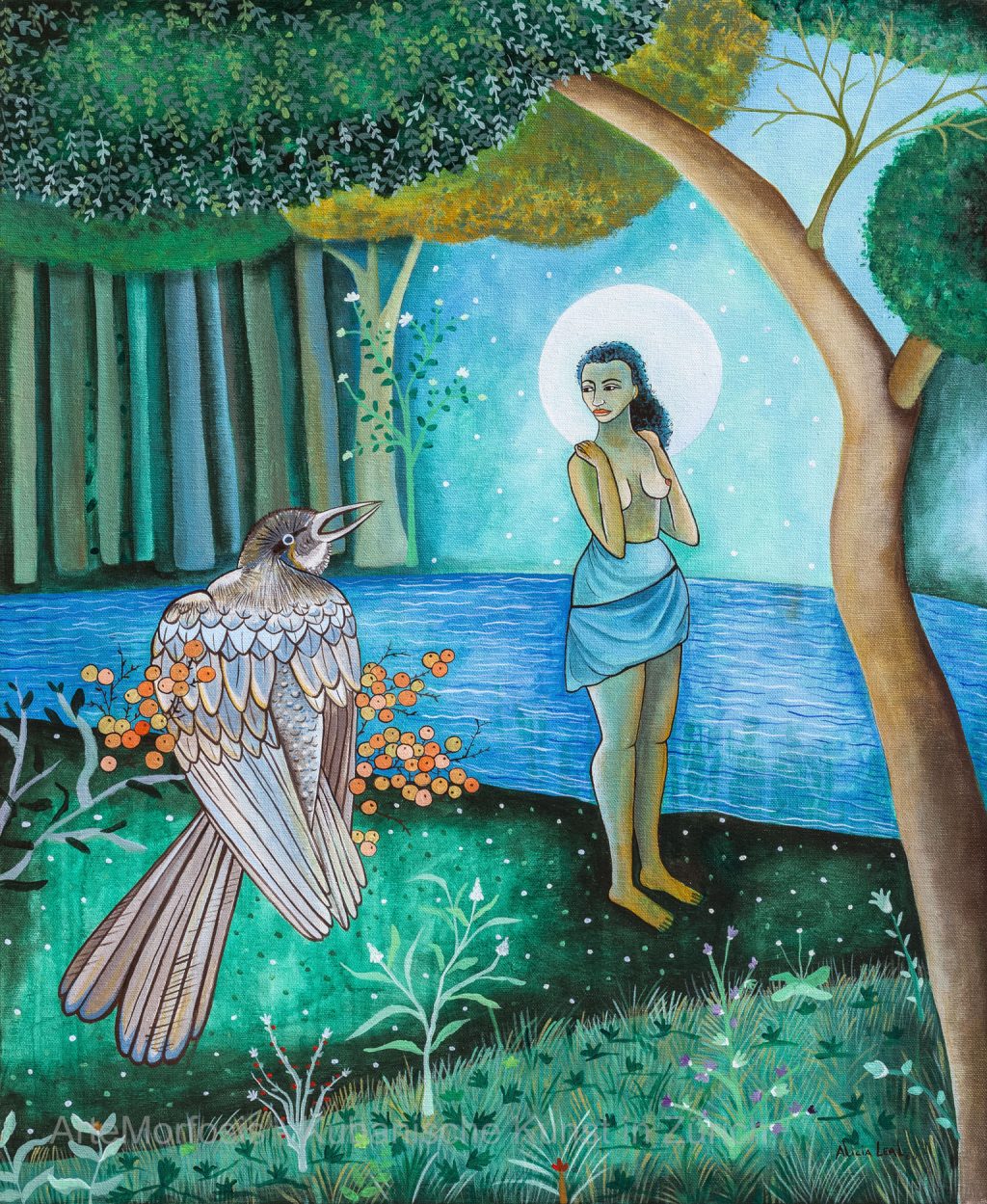Alicia Leal
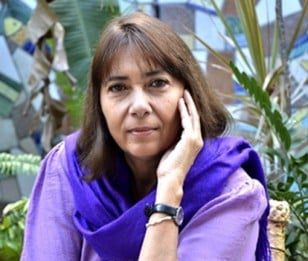
Alicia Leal (*1957) courtesy of the artist
Catharsis and Authenticity
–VIRGINIA ALBERDI
–Art Critic
A young woman flies along with a rooster whose wings have the colors of fire and the sky. One ignores where it comes from or heads to. The retina only fixes one and the other on the front plane, with a background of very light trees and waves (are they waves or bubbles?) that hardly support the painting’s main characters.
Another young woman hides her head in her thorax, accompanied by doves and illuminated by a sun of honey-colored rays, leaving a rain of fine spores suspended in the air ( in the air or on the earth?)
Fables without morals? Stories without words? Narrations or metaphors? To what extent does reality mix with dreams and dreams with reality?
These questions are born from observing Alicia Leal’s work, in this case the latest one, the ones of recent years and even some made five years ago. But they might also emerge from a retrospective of her creation, at least from the moment when she defined an unmistakable art form.
Someone might say that Alicia is an artist touched by an elf. Others attribute her virtues to a kind of state of grace. I would say that we are in front of a personality that has succeeded in finding those magic strings that emerge from her visual repertoire with intuition, craftsmanship, persistent search, imagination, wisdom and communicational vocation.
Without stridency or sudden jumps, discreetly but decidedly, Alicia Leal has conquered both demanding specialists and simple spectators in Cuba and abroad. No one connects her with the topics of the Cubanness, but almost surely her work wouldn’t be what it is if she hadn’t been born and lived on an island that grants her experiences, challenges and revelations.
. . .
A first explanation of Alicia’s artistic profile is to be found in the family environment. Her grandparents arrived to Cuba’s central region from the Canary Islands. There, in that Spanish archipelago, they still hadn’t met. The relationship was born in Antillean lands. Her parents, first-generation Cubans, always honored their ancestry, but obviously assumed a new feeling of belonging.
Although Alicia moved to Havana when she was very small, she never lost her link with her peasant origins in a flat zone, south of the old village of Sancti Spiritus, where the soil is predominantly adequate for the cultivation of tobacco. The place she was born in is called Las Varas. It is difficult to locate it in an ordinary map, on the borders of the Taguasco municipality.
In the first decades of the twentieth century, hundreds of Canary Islanders settled in those places and many of them never returned to the starting point. They contributed their customs, idioms, dishes, legends and idiosyncrasy to the Cuban material and spiritual culture, on the basis of an intimate integration that made them become an inseparable part of the Cuban identity in its rural component. Representative of that culture are the tunes, ten-stanza verses, ghost stories, wakes, parlor games, proverbs and riddles.
It was, and still is to a certain extent an oral culture – despite the reduction in the differences between city and countryside taking place in the last fifty years – where images are mainly constructed on the oral memory.
This is an important element – as we shall see later on – in order to understand certain codes that appear in Alicia’s work and the artist’s relation with a creative trend –the so-called naïf or ingenuous art, which I prefer to call popular art – which had extended in that region and become a tradition. Because, unlike other painters of that trend, from the canonic times of customs officer Rousseau to our days, popular painters and draftsmen from Las Villas (the Island’s central territory) have taken more interest in illustrating fables and inventing fantasies than in painting landscapes and customs-and-manners scenes.
As a child, Alicia traveled many times to Las Varas in her school holidays. She recalls having once seen “a blossoming bougainvillea escorting the ghosts of her torn down house, where a certain midwife delivered her in hard labor”. Among her most recent memories is the day when the horse she was riding bolted and she ended in a stream.
Already in Havana, an adolescent, she matriculated a secondary school that prepared for the military career. Lacking the vocation to fulfill that destiny (her father was an officer of the Revolutionary Armed Forces), Alicia found refuge in a very unique inner world: she wrote, drew and narrated stories in the form of comic strips. A neighbor her age who admired that spontaneous creative ability, told here about schools where she would be able to channel those aptitudes. The girl succeeded in convincing her parents to let her try an art school.
She then matriculated in Havana’s San Alejandro Fine Arts Academy, the oldest institution of its kind in the island. Toward 1975 it was undergoing a gradual renewal of its teaching projections, in tune with the improvement in the country’s art teaching system. In the old days San Alejandro had been the bulwark of the strictest academicism, when the pedagogic line was based on the romantic aesthetics that became evident in the conventional landscapist art. It was a time when hedonism per se and distancing from all that implied aesthetic or social questioning were promoted as immovable ideal, while assuming as correct the imitation of the Barbizon and Fontainebleau French schools or the Spanish San Fernando’s. The foundation of the National School of Art by the country’s new authorities in the early 1960s established the guidelines of a system of solid and the same time free premises that very soon extended throughout the country.
San Alejandro was not only a period of technical training for Alicia, but in the first place a period of cultural initiation. She had arrived there as a ‘blank canvas’, if we may use that expression. The history of universal and Cuban art penetrated her eyes and pores together with the rigors of drawing, modeling and composition.
Among the teachers who oriented her were José Fowler, whose pedagogic excellence she recalls very well; in the final courses the already promising Roberto Fabelo, from whom she received drawing and painting lessons, and the venerable sculptor José Antonio Díaz Peláez, a full master in art.
In those days she learned to admire the painting and drawing of Cuban maestros Carlos Enríquez and Ángel Acosta León, developed a preference for Henri Matisse and was impressed by the life and work of Mexican Frida Kahlo. Another Mexican also powerfully called her attention: Remedios Varo, of Spanish origin and creator of images close to surrealism, whose human figures are symbolically projected. This element should be taken into consideration because of the influence she received from this artist, not from her style but from her attitude. Among current creators she has a marked preference for the work of one of Cuba’s most outstanding artists, Flora Fong.
The times she lived in an old mansion in Havana’s historical center, a few steps away from the Cathedral Square, surrounded by writers, artists and others prone to bohemian life, somehow influenced Alicia’s future.
. . .
Whoever appreciates the artist’s paintings will hardly connect her to the expressionistic style. It so happened that in the final years of her studies and early 1980s expressionism was the aesthetic trend that most interested her, but she did not feel comfortable in it. Poncito, one of the neighbors of the above-mentioned Old Havana mansion and son of Fidelio Ponce de León, a master of Cuban twentieth-century avant garde, compelled her at that moment: “Be yourself, search inside yourself and you will find yourself”, were his words.
She then had to solve quite a different equation: putting herself in front and responding to her interior voice meant distancing herself from what she pretended others to see in her work; it meant discarding the fashion rites and ceasing to see herself through others’ eyes. Feeling more than thinking? Trusting intuition and not conviction? No. It was more a question of thinking the feelings, of feeling new convictions.
The encounter with the popular tales collected by folklorist, draftsman, painter and poet Samuel Feijóo, one of the most restless and unclassifiable creatures of twentieth-century Cuban cultural life was a revelation. Restless walker, receptor of true or untrue stories told by peasants, agricultural workers and the humblest people he found in the island’s central region – the same where Alicia had been born – Feijóo played a role in the artist’s recovery of the memory of her original environment.
But that happened in oblique form. Neither was Alicia an artist like the ones Feijóo stimulated and sponsored in one of his many promotional facets, recognized as popular painters and draftsmen from Las Villas (Duarte, Ñika, Alberto Anido, Aidaida, Aslo and a few others), nor was she interested in becoming one. She was not and did not pretend to be naïf like the painters from Trinidad and Sancti Spiritus, established from then on as icons of a paternalistically called primitive trend.
However, she did not approach this trend, either, as others have done, through parodic appropriation or ambiguous paraphrases. Italian semiotic Stefano Traini recalls how, from the second half of the twentieth century on, there have been those who “search the naïf lack of precision as cultured effect” , and mentions bad painters in the United States and graffiti artists who “deliberately seek carelessness”.
In Alicia Leal, the journey to her origins and the spiritual growth that has sustained her work are processes full of autochthony that respond to the sensibility of an artist whose emotional supports articulate organically with her intellectual perspectives.
Throughout time, her work has been moving in four essential directions that in many cases intertwine and nourish reciprocally: the memory (never a copy) of nature; femininity (never feminism); fables (never topical narrative) and the ups and downs of daily life (never customs and manners).
One has to believe her when she says: “Nature inserts itself in my work, with its signals and winks of mystery and life, and this conscious language presenting leading role of the feminine body. I perceive the world as a house where nature is confirmed. The woman is in the center of an existential conflict, with all these references, where the apparent is nothing but a pretext to penetrate deeply and widen the generic sense of artistic perception, adding new nuances to the representative universe of experience, but without estrangements, discovering mental feelings using a language with which I try to scratch the surface.”
It all depends of the tone, of the syntax that connects themes, motifs, animated and inanimate figures. On one side, the slight undulation; on the other, the glance in complicity. Eros sublimated and Orpheus on the flat lands of the Tropics. Deafened but audible rituals. Defined and at the same time caressing lines.
. . .
Alicia Leal arrives in Zurich with the results of her painting experience and at the same time as bearer of a vivifying content that grows with time. She has multiplied creation in other spaces. In book illustration she has left a perceptible trace, with a first stop in the editorial commission to accompany Iré a Santiago, a collection of poems by different authors dedicated to the city of Santiago de Cuba. Then she performed in the heights when she illustrated chants from The Divine Comedy. She found challenges and affinities in the poems of her fellow countrywomen Lina de Feria and Olga Navarro and in Cuban Stories and The Old Mill, narrations of Belgian Philippe Calon, in addition to fulfilling commissions of several literary magazines and publishing houses specialized in children’s books.
She has also dedicated efforts to photography. Her exquisite creations have been admired in several exhibitions. One of the most significant works in that field was the illustration of a book of poems by painter and poet Juan Moreira. The artist considers working with the camera as a certain extension of her aesthetic concerns, although in her opinion photography is condensation and silence, concentrated intimacy. She admits sharing a gender point of view in both artistic practices, but nothing else.
Glancing at her recent paintings confirms these words of hers: “The artist lives in constant catharsis. Making the work is nothing but liberating feelings, ideas, or one’s greatest secrets from the subconscious to the outer world – leaving the superfluous aside; finding the keys to creation, making the handicraft part of the work, of the modeling; translating the relations that surround the artist and the work to gradually create a network that will enable the transmission of a state of mind, whether from sexuality, rage, hatred or despair. Everything takes a meaning, a harmony; there are no ambivalences, because it becomes communication, discourse”.
Her constant dedication to the most pure exercise of art, which has placed her among the most renowned Cuban artists both in Cuba and abroad with a presence in galleries, museums and prestigious institutions, has not prevented her intense participation in charitable and social actions.
. . .
Everything said about the artist and her work is evidenced in the contrasted feminine figures – day and night? – in Tu nombre es soledad (Your Name is Loneliness), but also in a different way, because of the metaphysical connotations, in Hacer el tiempo (Making Time) and Mundos compartidos (Shared Worlds). Behind the exuberant filigree in La montaña y la ardilla (The Mountain and the Squirrel) one may sense the labyrinths of fables in an opposed sense to the one shown in La novia del árbol (The Tree’s Fiancée).
From the lyrical evocation of Baño de luna (Moon Bath), Mi verso es un ciervo herido (My Verse is a Wounded Deer) and Dentro de ti florezco (I Bloom inside You), without the slightest deviation from her constructive principles, the artist goes to the enigmatic symbolism of Recurso natural (Natural Resource) or the hieratic attitude with which she oddly pays tribute to the great Cuban painter Wifredo Lam. Testimonies that are closer to daily reality, though deprived of the anecdotic and relevant, are the works Burbujas y una visa Americana (Bubbles and a U.S. American Visa), De La Habana a Berlín (From Havana to Berlin) and a vernacular piece that synthesizes allegorically the island’s productive and human landscape.
The traces of popular iconography irrupt in Lágrimas de fina lluvia (Tears of Thin Rain), Toda Cuba dividida en horizontes (All Cuba Divided into Horizons) and Todo cabe bajo el manto de la Virgen (Everything Fits under the Virgin’s Robe). They are works that reveal and recreate one of the main signs of religiosity of Cubans, who invoke the protection of the Virgin of Charity of Cobre, consecrated as patroness of Cuba, for human and divine, in joys and disgraces, with brain and heart, irrespective of the cults they profess. Even those who declare themselves agnostics cannot elude the gravitation of this symbol of national culture. In the pieces that make up this show there is evidence of how the creative maturity of this artist and her achievements reach subtly masked philosophical profoundness. Technically, one notes changes in the use of color, dripping and backgrounds that become complex in order to achieve novelty environments.
In the end, the observation of Alicia Leal’s work remits us to a perception that has been a milestone in the relation between the creation and its enjoyment from immemorial times, as resumed by the famous theorist Yuri Lotman: “Art is always a possibility to live what we did not live, to go back, to solve again and to do it in a new way. It’s the experience of what did not happen. Or of what may happen”.
VIRGINIA ALBERDI, Art Specialist, Havana, March 2016
Virginia Alberdi Benítez (Virginia Alberdi Benítez, 1947) Virginia Alberdi Benítez, 1970. Virginia Alberdi Benítez, editor of Artecubano editions. Virginia Alberdi Benítez (Virginia Alberdi Benítez). Virginia Alberdi Benítez, Virginia Alberdi Benítez. Virginia Alberdi Benítez. Virginia Alberdi Benítez, Virginia Alberdi Benítez, Virginia Alberdi Benítez, Virginia Alberdi Benítez, Virginia Alberdi Benítez, Virginia Alberdi Benítez. Virginia Alberdi Benítez.

